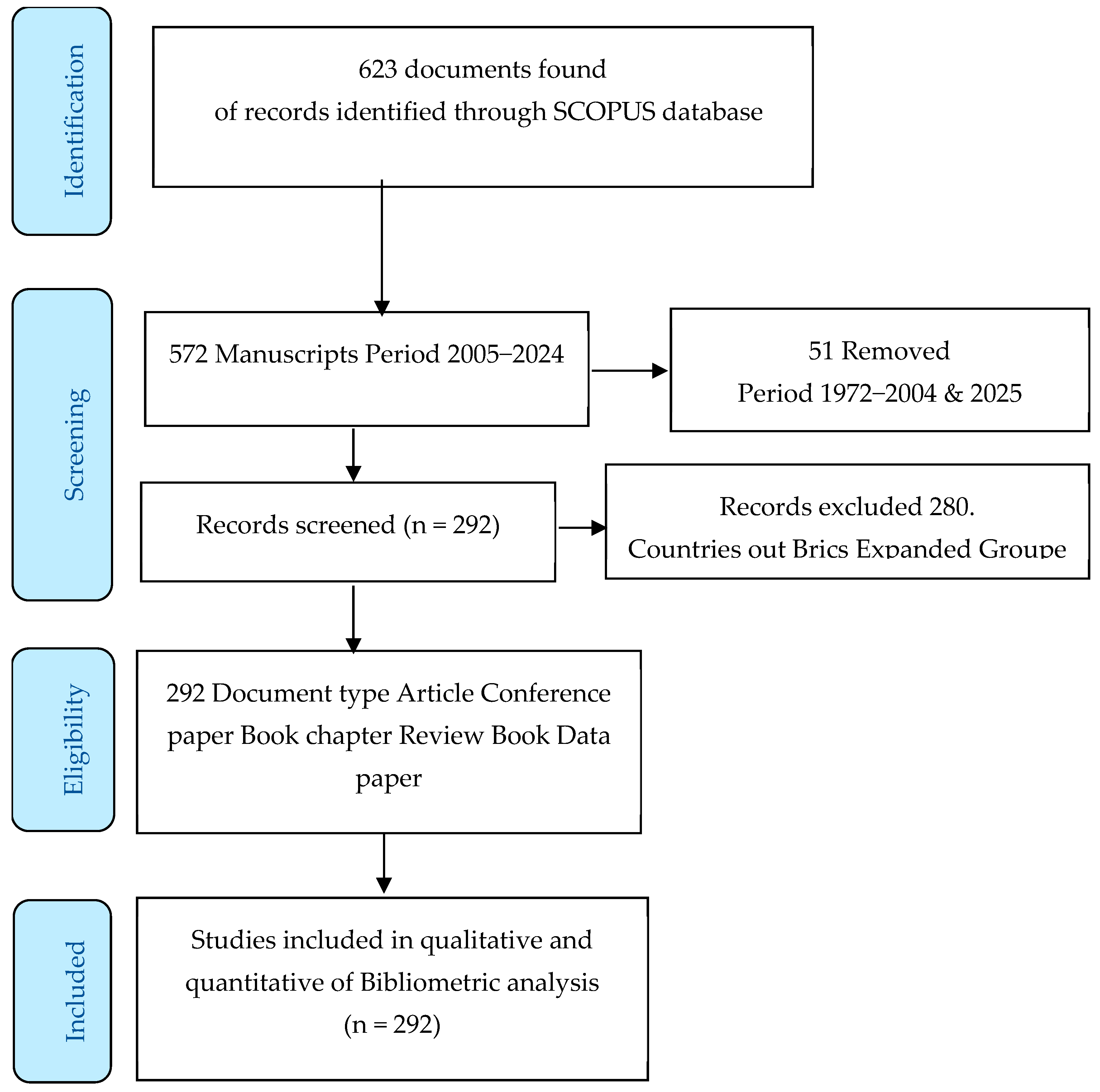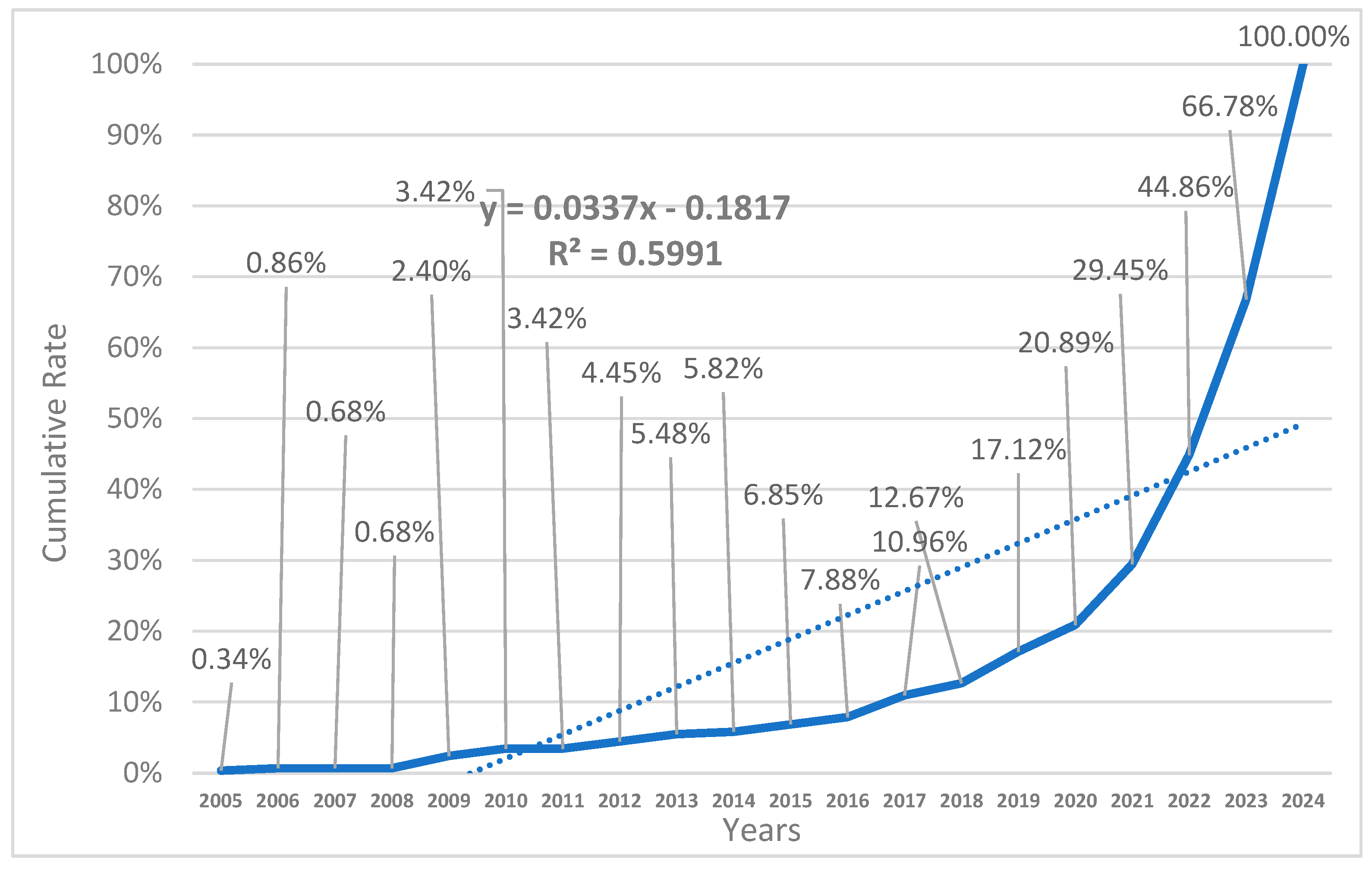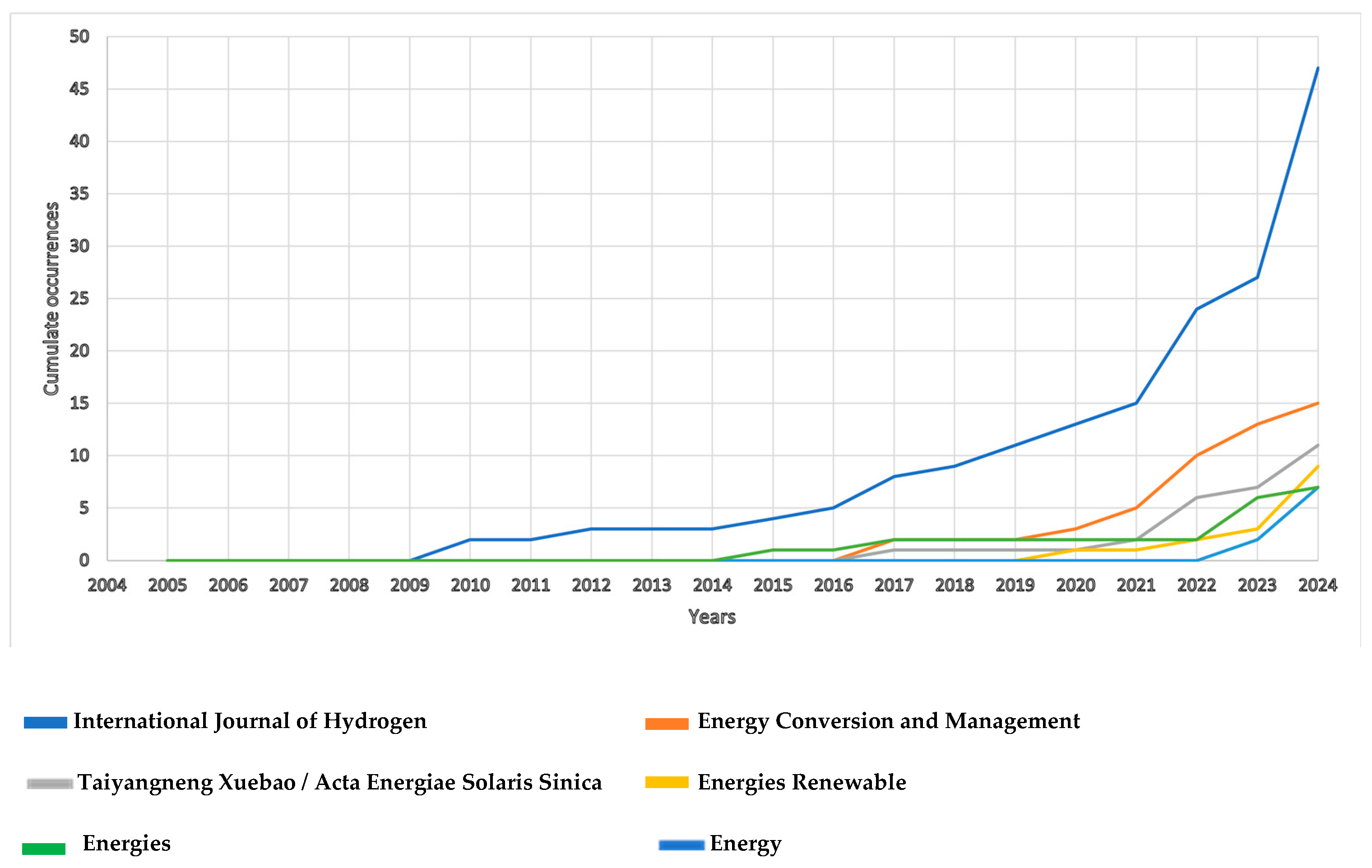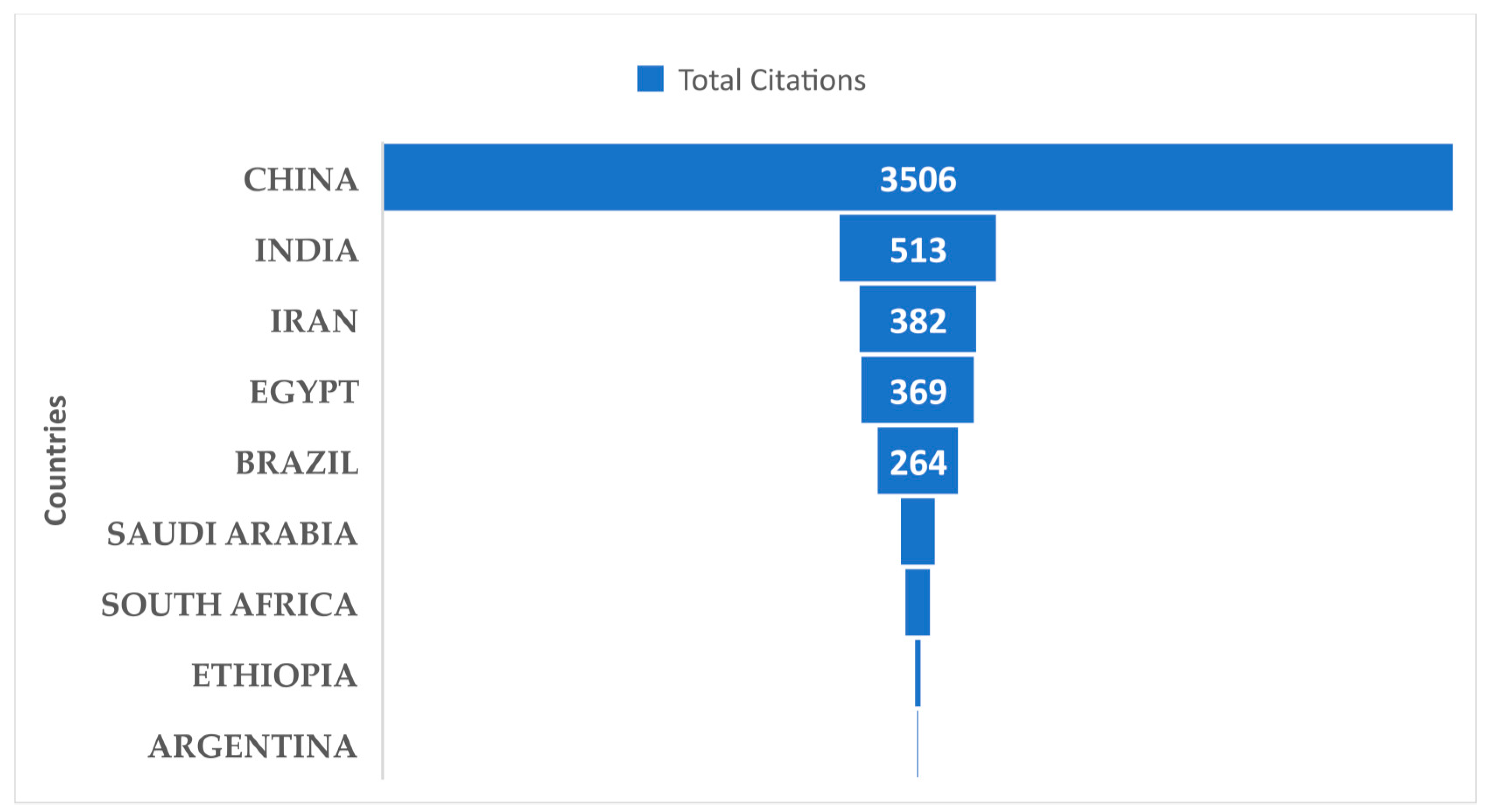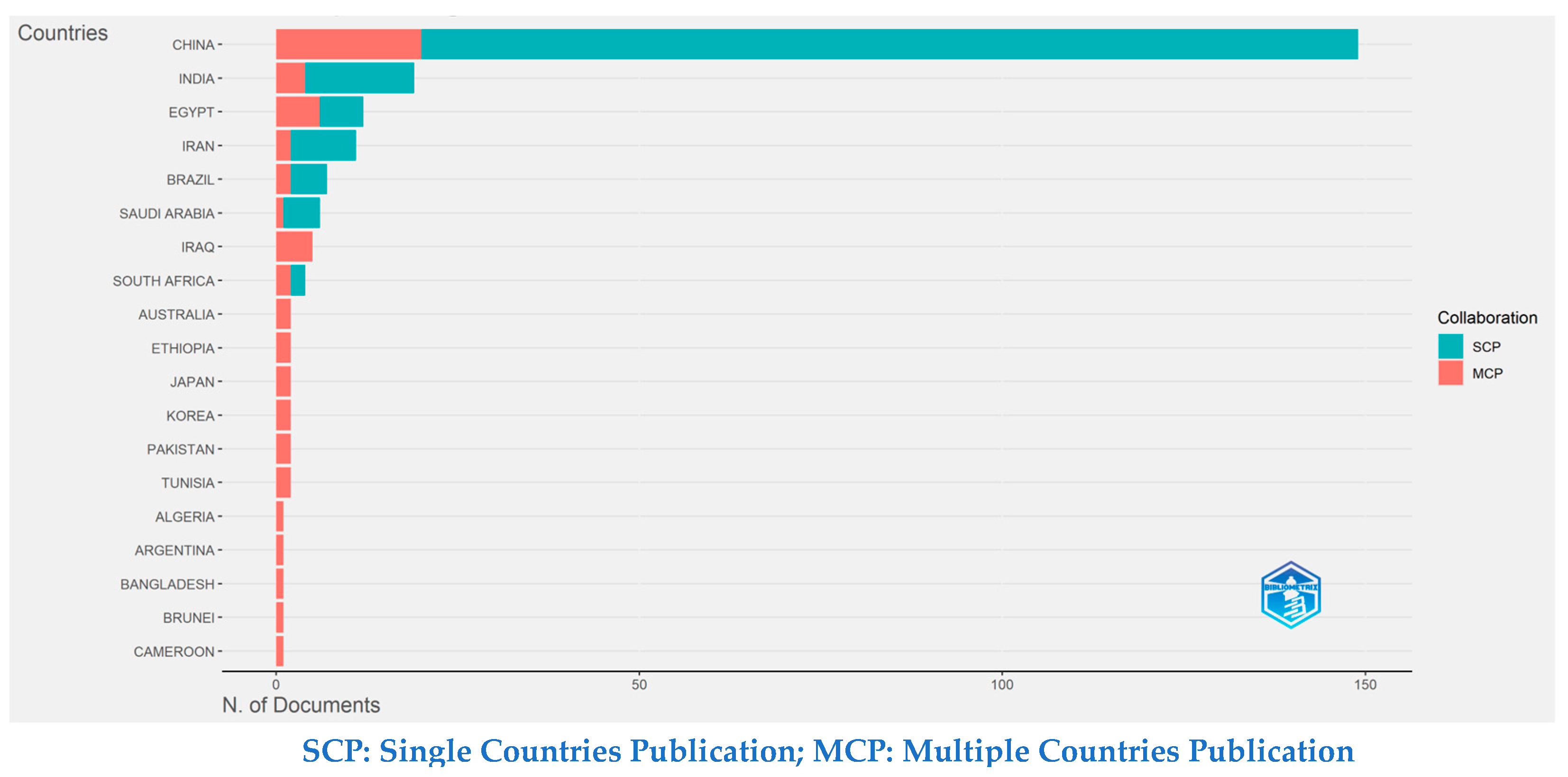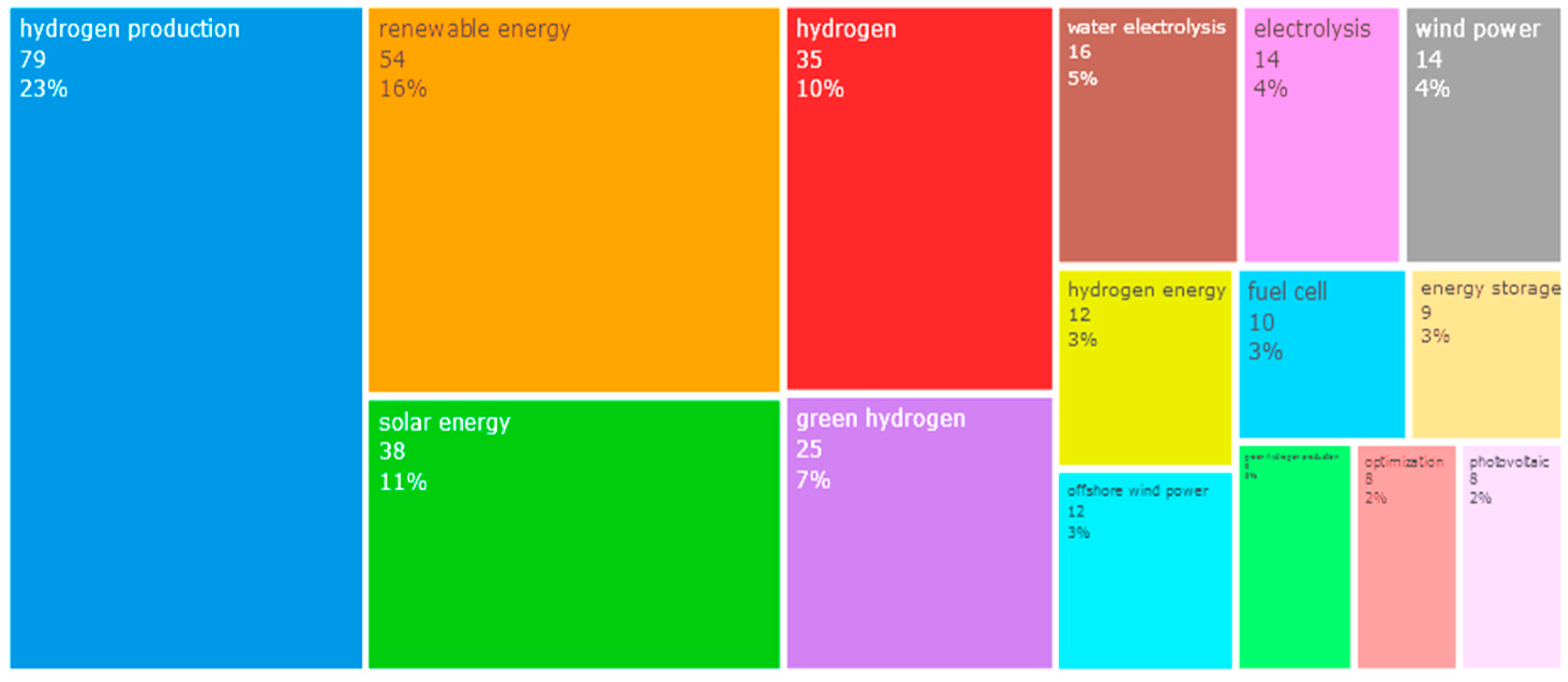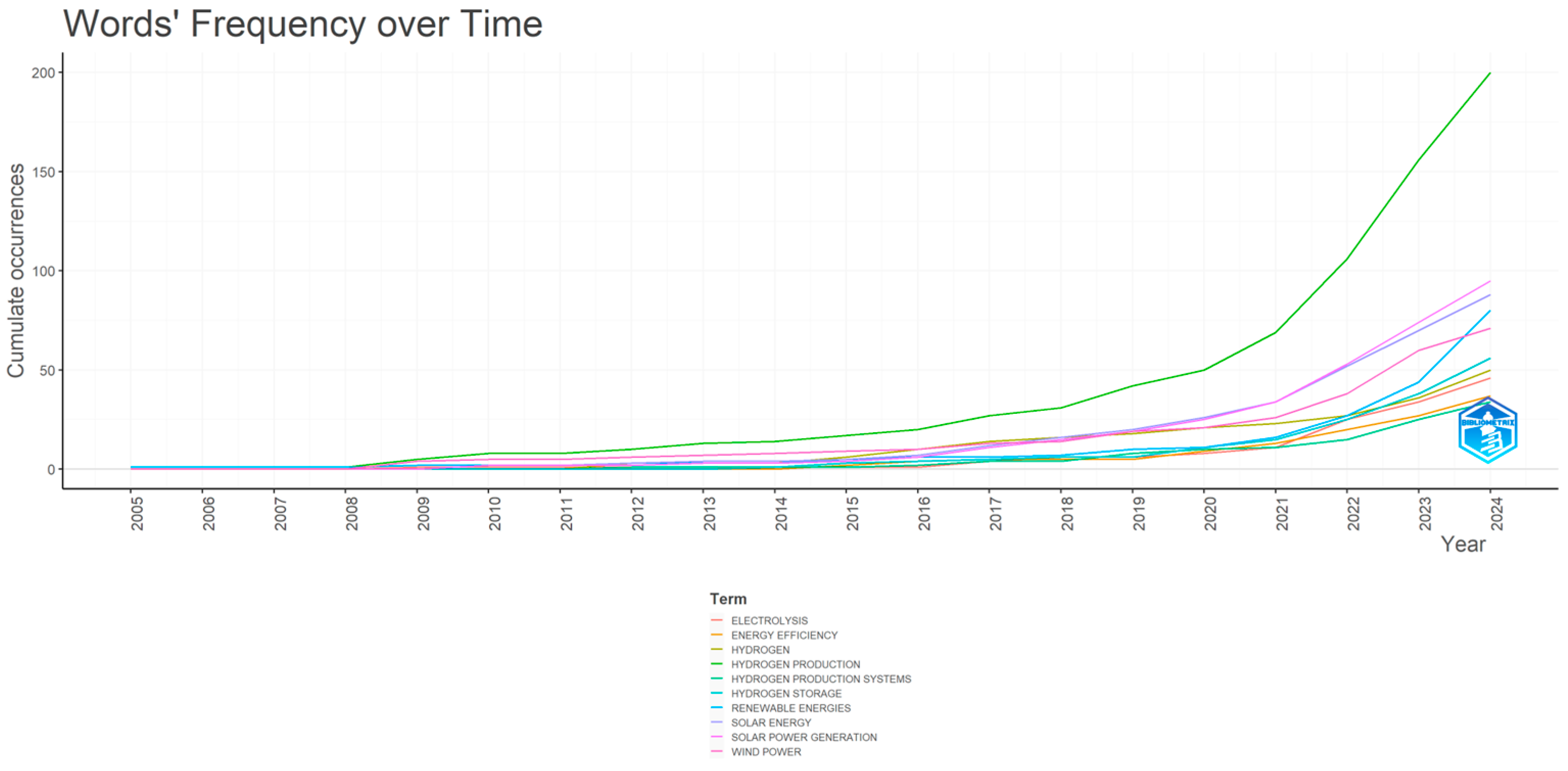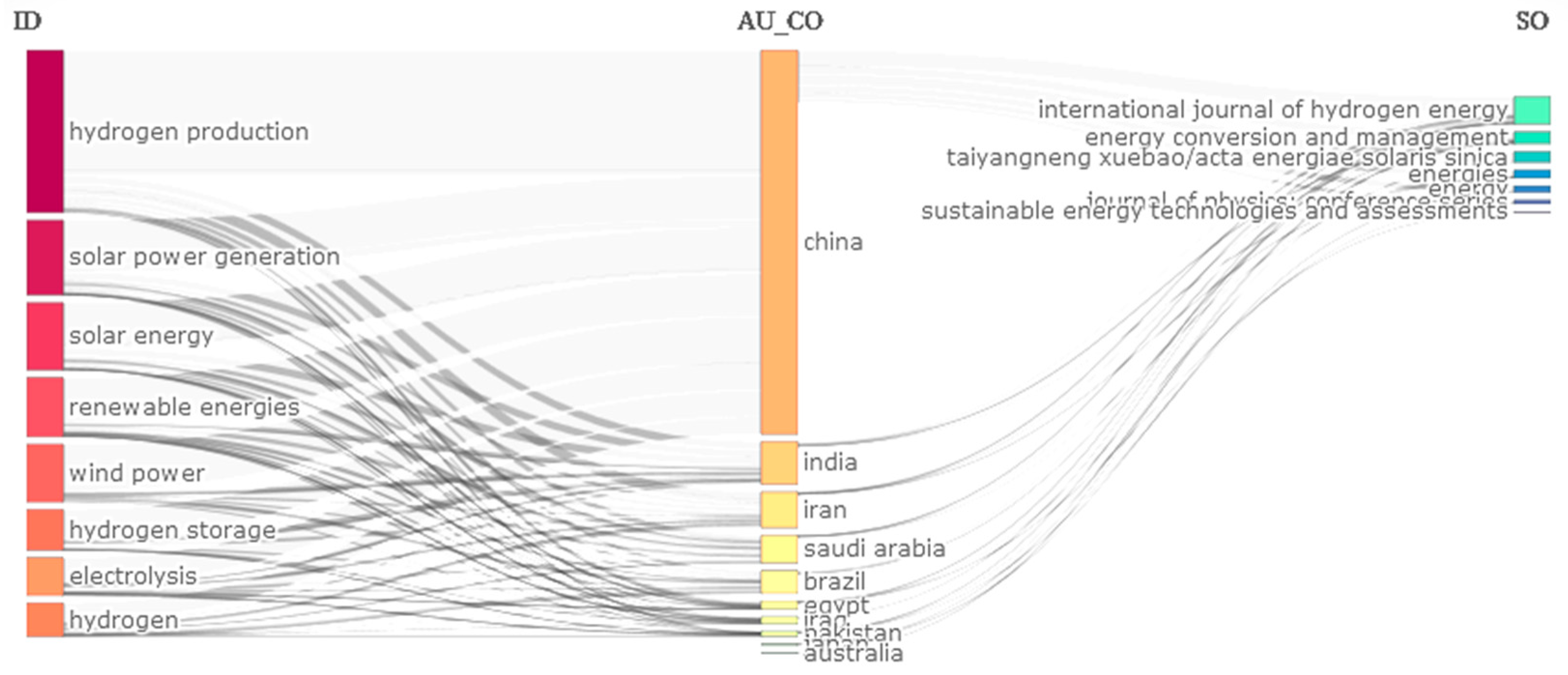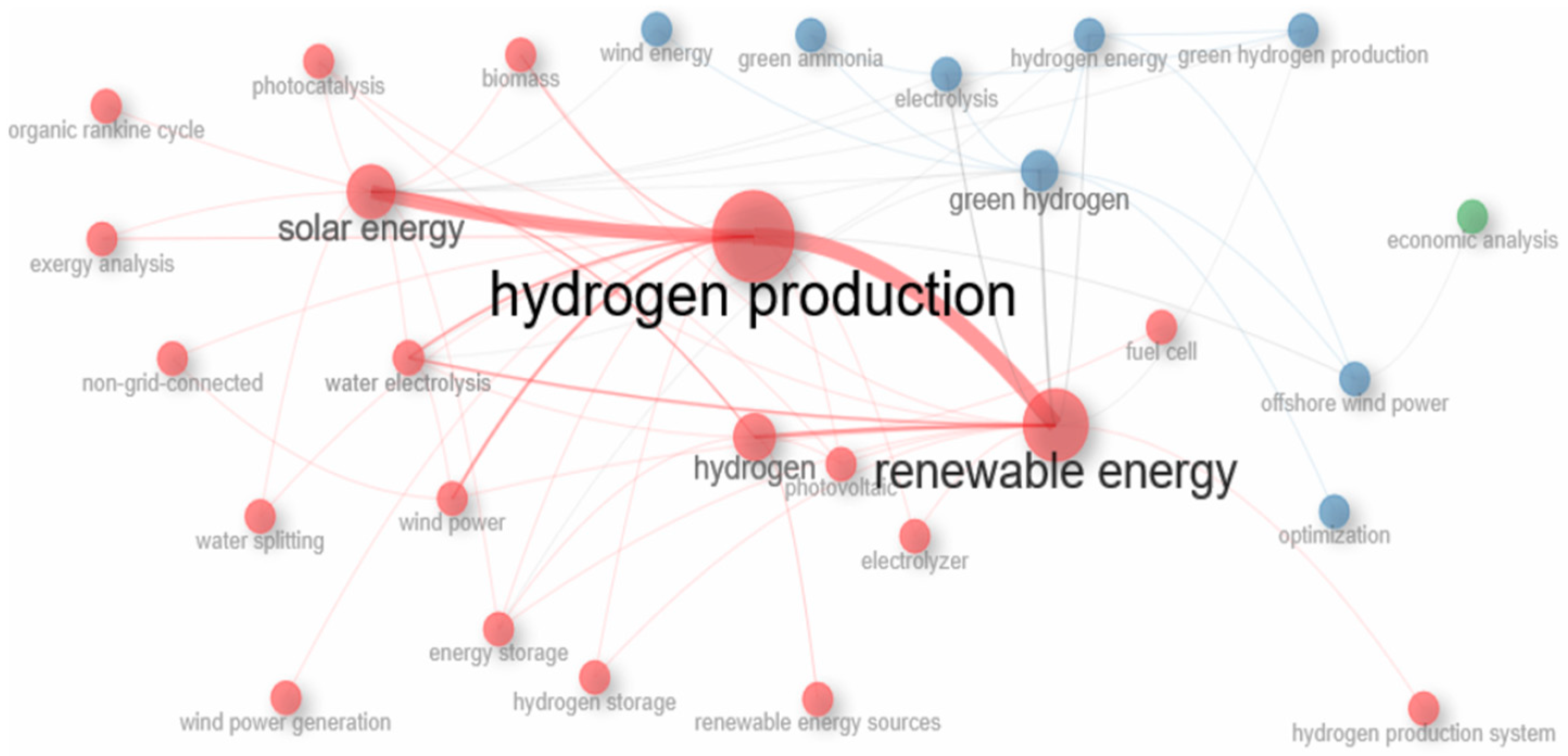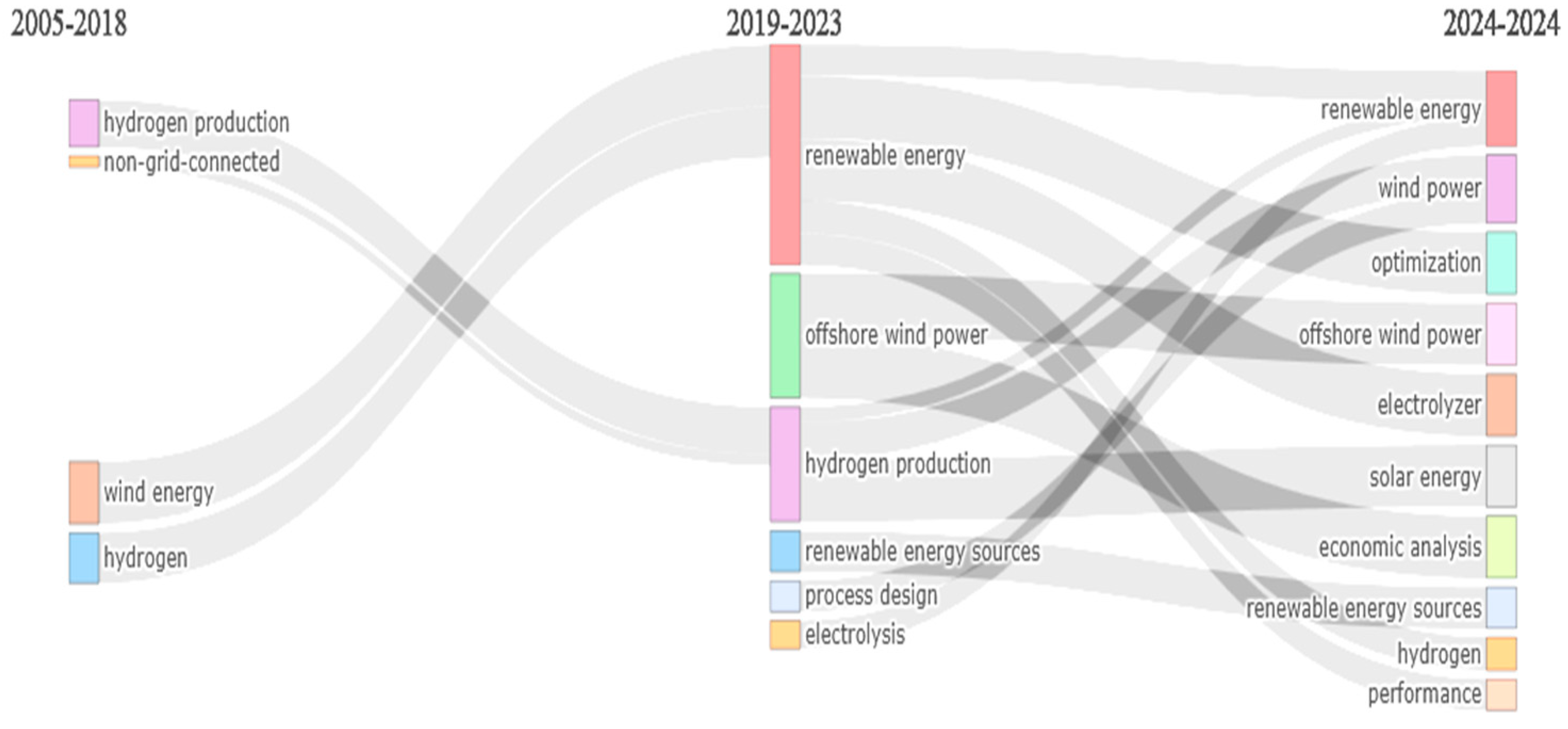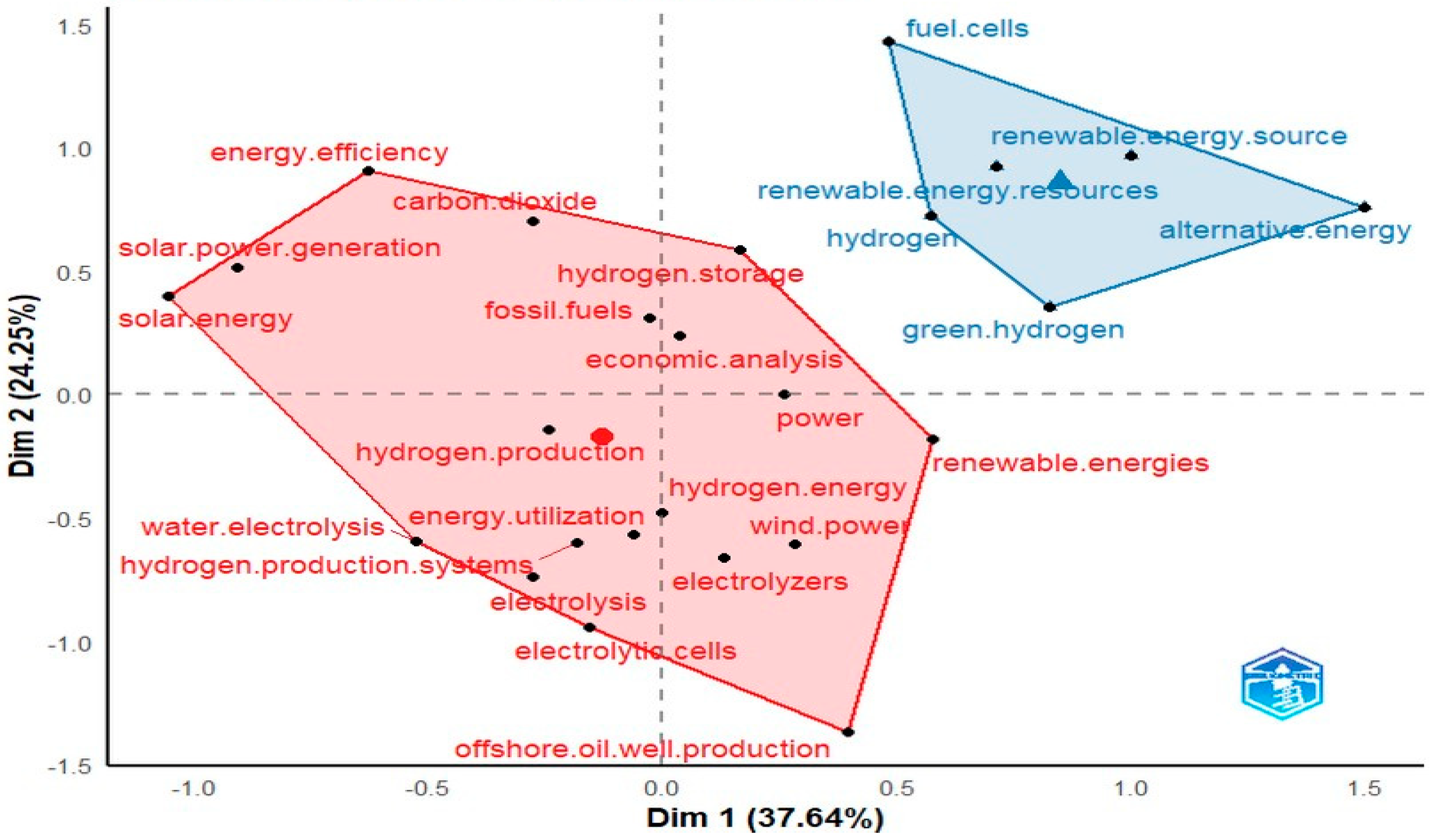1. Introduction
Climate change and energy security concerns have made the global shift to renewable energy an urgent priority. According to the Intergovernmental Panel on Climate Change (IPCC, 2018), restricting global temperature rise to 1.5 °C demands urgent and extensive shifts within energy infrastructures worldwide underscoring the need to accelerate clean energy adoption. In this context, green hydrogen has risen to prominence as a sustainable energy carrier and a key pillar of decarbonization strategies. Produced via electrolysis powered by renewables, green hydrogen can replace fossil fuels in applications that are hard to electrify—such as heavy industry, long-haul transport, and seasonal storage—without emitting carbon dioxide. However, developing efficient and low-cost noble-metal-free photocatalysts remains one of the daunting challenges in low-cost H
2 production [
1]. Many decarbonization scenarios now anticipate hydrogen playing an important role in achieving a net-zero level in the future, for example, the International Energy Agency (IEA, 2019) projects that hydrogen could meet roughly 12–13% of the global final energy demand by 2050. This growing optimism reflects hydrogen’s immense potential to drive the transition to a carbon-neutral world. Emerging economies in the extended BRICS group (Russia, China, South Africa, India, and Brazil) are central to the renewable energy transition due to their sheer scale and rapid growth. Collectively, the nation’s comprising BRICS represent approximately 40% of the global population and consume close to 40% of the world’s energy consumption, and they generate a substantial share of greenhouse gas emissions [
2]. Their energy policies and innovation trajectories will thus heavily influence global decarbonization efforts. Recognizing this responsibility, BRICS nations have increasingly turned their focus toward renewable energy and green hydrogen development. China and India, in particular, have launched ambitious national hydrogen programs (e.g., China’s fuel cell vehicle plans and India’s National Hydrogen Mission), while Russia, Brazil, and South Africa are investing in pilot projects and strategies to harness green hydrogen for industrial use and export [
3,
4]. This momentum across the extended BRICS group points to their intention to become key players in the emerging hydrogen economy. Indeed, strengthening research and innovation in green hydrogen will be pivotal to positioning these nations at the forefront of the global transition toward sustainable clean energy.
Despite the growing importance of green hydrogen in the extended BRICS group, there is a notable gap in the literature when it comes to systematically mapping and understanding the research in this domain for these countries. To date, most bibliometric analyses of hydrogen energy have taken a global or technology-specific view, without a dedicated focus on the BRICS economies. For instance, Ref. [
5] conducted a bibliometric study on green hydrogen production, storage, and utilization worldwide, demonstrating extensive research activity in sustainable hydrogen technologies. Similarly, various studies have reviewed renewable energy research trends in general (e.g., using bibliometric methods to analyze the water–energy–food nexus or renewable integration) without zooming in on the BRICS context. However, no prior work—to our knowledge—has specifically examined the evolution of the green hydrogen research within the extended BRICS nations as a distinct group. This represents a significant research gap, given that these countries’ trajectories in hydrogen R&D may differ from global patterns due to their unique economic, policy, and resource contexts. Addressing this gap is not only of academic interest but also of practical importance. A systematic mapping of the scientific literature in this domain can yield critical insights for policymakers, researchers, and industry stakeholders. By revealing who is publishing on green hydrogen, in what subtopics, and with what impact, such an analysis helps identify the strengths and weaknesses in the current knowledge base. It can inform decision-makers about where to channel resources or foster collaborations, and highlight opportunities for technology transfer and innovation. In essence, bibliometric mapping provides a mirror of the research landscape, helping stakeholders see the trends and networks that might otherwise remain obscure in the deluge of publications. Therefore, a bibliometric approach is an invaluable tool for understanding the progress of green hydrogen research in the extended BRICS group and for guiding its future development.
Based on the foregoing ideas, this study seeks to fill the noted gap by systematically analyzing the green hydrogen and renewable energy research landscape in the extended BRICS countries using bibliometric methods. Specifically, this study examines publications from 2005 to 2024 to characterize how this field has evolved in these emerging economies. We investigate publication trends, key sources of knowledge, collaborative networks, and the thematic structure of the research, with the goal of providing a wide-ranging and in-depth synthesis of green hydrogen research in the BRICS context. To guide this investigation, we pose the following research questions:
RQ1: How have annual scientific production and influence evolved between 2005 and 2024?
RQ2: Which sources are the most impactful, prominent, and dynamic in this field?
RQ3: How is the impact and collaboration of different countries distributed in this domain?
RQ4: What is the intellectual structure of the field, including the most influential documents, co-citation patterns, and the historiographic evolution of manuscripts?
RQ5: How is the conceptual structure of the research field characterized, based on elements such as TreeMap visualization, three-field plot (Countries–Keyword–Source), co-occurrence network, and thematic evolution?
By addressing these questions, this study provides a data-driven picture of green hydrogen and renewable energy research in the extended BRICS milieu. The novelty and originality of this study lie in its exclusive bibliometric focus on the extended BRICS nations—a region that has been largely overlooked in previous hydrogen energy analyses. Unlike prior global or technology-specific bibliometric reviews, this study systematically maps the green hydrogen research landscape in these emerging economies, providing the first evidence-based synthesis of publication trends, influential actors, and thematic developments within this strategic geopolitical bloc.
The subsequent sections of this manuscript are arranged in the order described below:
Section 2 presents a succinct literature review that synthesizes previous work on green hydrogen and renewable energy, highlighting both bibliometric studies and alternative review approaches.
Section 3 describes the methodology, detailing the data collection process, filtering criteria, and the bibliometric tools used for performance, intellectual, and conceptual analysis.
Section 4 reports the results, including publication trends, key metrics, and network visualizations.
Section 5 discusses these findings in light of the policy implications and future research directions, and
Section 6 brings the discussion to a close by recapping the main contributions and offering suggestions for future research. Finally,
Section 7 presents the conclusion, summarizing the key findings, addressing the limitations, and suggesting future research directions for further exploration in the field.
6. Discussion
The bibliometric analysis of the green hydrogen and renewable energy research within the extended BRICS nations provides a structured understanding of the research field. This discussion responds to the key research questions by examining the trends in scientific production, the most influential sources, international collaboration, intellectual development, and the conceptual structure of the field.
R-Quest1: Evolution of Annual Scientific Production and Influence (2005–2024)
GH and RE research output has grown steadily between 2005 and 2024, with a notable surge after 2018. Early research between 2005 and 2012 largely focused on fundamental hydrogen production methods and renewable energy integration, as noted by [
6]. The subsequent period (2013–2024) saw a transition towards applied investigations, including economic feasibility, policy frameworks, and electrolysis advancements [
36]. This pattern aligns with the global shift toward decarbonization policies, which have fueled scientific and industrial interest in GH technologies. However, citation analysis highlights a fluctuating impact, with a peak in citations between 2015 and 2020, which can be attributed to major breakthroughs in hydrogen storage and utilization [
8]. The declining trend in recent years suggests an increasing volume of publications leading to citation dispersion, a phenomenon observed in maturing research fields [
23].
R-Quest2: Most Impactful, Prominent, and Dynamic Sources
The
International Journal of Hydrogen Energy emerges as the most influential journal in the field, with a high total citation count and productivity, reflecting its pivotal role in advancing the hydrogen technology research [
4]. Other impactful sources include
Energy Conversion and Management and
Renewable and Sustainable Energy Reviews, both of which have contributed significantly to studies on renewable integration and techno-economic evaluations of hydrogen production [
13,
16]. Additionally,
Applied Energy and the
Journal of Cleaner Production have provided substantial contributions to the economic and sustainability aspects of hydrogen energy, indicating an increasing interdisciplinary focus on the GH research [
12]. The diversity of sources highlights a convergence of the technical, economic, and policy-driven research on green hydrogen and renewable energy within the extended BRICS region.
R-Quest3: Impact and Collaboration of Different Countries
China leads the GH and RE research in the extended BRICS group, both in terms of the output and impact, followed by India and Russia, reflecting their strong governmental and industrial commitments to hydrogen development [
3]. India focuses on solar-based hydrogen production and electrolysis, while Russia’s contributions highlight the advances in hydrogen storage and hybrid energy systems [
17]. South Africa and Brazil, though with less contributors, show a growing engagement in the hydrogen research, often in collaboration with global partners. International co-authorship rates stand at 25.68%, signifying a robust global collaboration, particularly between BRICS and European institutions [
10]. The partnerships reflect the global urgency for hydrogen-based solutions and the role of BRICS nations in shaping the future of sustainable energy transitions.
R-Quest4: Intellectual Structure and Historiographic Evolution
The historiographic analysis identifies the key foundational works that have significantly influenced GH and RE research trajectories. Studies, such as [
37], on water electrolysis [
38], on bio-hydrogen production, and [
38,
39,
40] on techno-economic assessments serve as major intellectual anchors in the field. Co-citation analysis reveals thematic clusters, primarily focused on hydrogen production technologies, economic feasibility studies, and policy frameworks [
25]. The research has evolved from theoretical production models to applied solutions addressing commercialization and supply chain optimization [
28]. Bibliographic coupling further indicates an interdisciplinary transition, linking the hydrogen research with sustainable development, climate change mitigation, and policy implementation [
27]. This intellectual progression suggests a maturing research field with increasing real-world applicability and policy relevance.
R-Quest5: Conceptual Structure of the Research Field
The TreeMap visualization of the GH and RE research highlights “Hydrogen Production” as the dominant thematic area (23%), followed by “Renewable Energy” (16%) and “Water Electrolysis” (5%), reflecting the field’s emphasis on production methods and energy integration [
6]. The three-field plot further establishes strong associations between leading research nations (China, India, and Iran), primary research themes (Hydrogen Production, Solar Energy, and Wind Power), and major publishing sources (
International Journal of Hydrogen Energy, Energy Conversion and Management), confirming the interconnected nature of research productivity and knowledge dissemination [
26].
Co-occurrence network analysis identifies three major research clusters. The Hydrogen Technologies and Applications cluster focuses on production, fuel cells, and storage solutions, reflecting industry-driven technological development [
9]. The Advanced Hydrogen and Emerging Technologies cluster examines offshore wind-based hydrogen production, electrolysis advancements, and process optimization, showcasing the research priorities in increasing efficiency [
15]. The Economic and Strategic Analysis cluster addresses financial feasibility, policy frameworks, and international hydrogen trade, demonstrating a shift toward market integration [
22].
Thematic evolution analysis classifies green hydrogen and renewable energy research into three periods. The 2005−2012 phase focuses on early hydrogen production techniques, particularly non-grid wind power generation [
18]. The 2013−2017 phase is an expansion into experimental technologies, such as biomass gasification and hybrid wind–solar hydrogen production [
16]. The 2018−2024 period is characterized by a shift toward commercialization, supply chain optimization, and large-scale hydrogen integration within systems [
20]. This evolution aligns with increasing industry participation and government policies supporting hydrogen economy development.
7. Conclusions
This research problem required a bibliometric investigation to study green hydrogen and renewable energy research developments in extended BRICS nations. The research into decarbonization and emerging economy contributions to global energy transformations requires a deep understanding of field development patterns and international partnerships and topics. This research study filled an important knowledge gap by creating maps of BRICS nations’ research publications about green hydrogen and renewable energy and analyzing their intellectual organization to develop strategic directions for future development.
This research shows that the green hydrogen and renewable energy investigation shows a steady expansion within the BRICS group after 2018, while China dominates in both research production and academic influence. Three main influential publications in the GH and RE research are the International Journal of Hydrogen Energy, Energy Conversion and Management, and Renewable and Sustainable Energy Reviews. Research collaborations primarily extend between BRICS institutions and their European counterparts. The research field on hydrogen production shifted from basic technical methods to add disciplinary applications, which focus on policy generation alongside economic validation and industrial use. The conceptual research directions concentrate on hydrogen production methods and electrolysis innovation as well as green hydrogen economic sustainability.
7.1. Discuss Implications
This research adds value to professional domains by conducting an extensive bibliometric evaluation of green hydrogen and renewable energy studies throughout BRICS economies. This study demonstrates the requirement for focused hydrogen technology investments as well as improved international sector collaborations and research agendas influenced by policy principles. BRICS nations continue their technological progress, which establishes them as leading stakeholders in the worldwide hydrogen economic framework. This research delivers valuable findings to help policymakers and stakeholders in funding agencies alongside industry leaders develop better energy transition approaches.
This research contains several limitations due to its extensive bibliometric method. The use of the Scopus database as an information source omits the research that appears in non-scoped journals together with regional research repositories. Malfunctions in bibliometric analysis generate useful quantitative data while lacking the capacity to measure policy effectiveness alongside the socioeconomic effects of adopting technologies for promotion. Additional research would benefit from including expert interviews as well as case studies to improve the bibliometric findings.
7.2. Future Research and Recommendation
Further research needs to evaluate the extended policy implications, which BRICS economies face due to their investments in green hydrogen and renewable energy development. Further insights into global energy transitions can be developed by performing a comparative analysis between the BRICS nations and other emerging economies. Environmental impact assessments and economic modeling methods combined with life cycle analyses will help professionals better evaluate the practicality of using GH. Research effectiveness would increase if studies delved into precise industrial sectors (such as transportation and heavy manufacturing) and their processes of transitioning to hydrogen-based energy systems.
